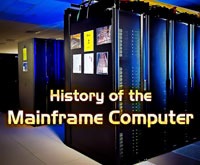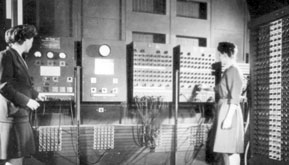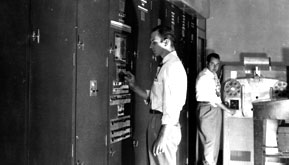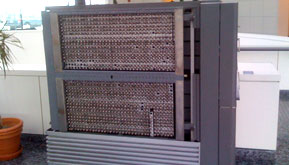In this era of smartphones, the mainframe computer is seldom heard about. It’s because common people do not really purchase it. A mainframe computer, which is also known as “big iron,” is a high-performance computer made for high-volume and processor-intensive computing. These are typically used by large businesses and other scientific purposes that require greater availability and security than a smaller-scale computer can offer.
The term mainframe nowadays is used to describe a style of operation, applications and operating system facilities. Most are calling these types of commercial use computer as a server, with the mainframe simply being the largest type of server in use.
Currently, the biggest manufacturers of mainframes are IBM and Unisys. Here’s some background for their history:
 ABC
ABC
Although the mainframe computer only truly started in the 1950s, we’ll start its story from the first electronic computer that was completed in 1942. The Atanasoff-Berry Computer (ABC) was recognized as the first electronic digital computer since it did all its computing using electronics unlike the earlier Harvard Mark I computer that used mechanical switches and hand cranks.
Its inventor, John Atanasoff, used vacuum tubes to amplify signals and act as switches. The logic circuits in ABC could perform addition and subtraction at 30 operations per second. This computer pioneered the important elements of modern computing like using electronic switching elements, binary arithmetic and capacitors for memory.
However, these get very hot and were very unreliable. It wasn’t even programmable. But the milestone it achieved was very important for the computers of the future. While Atanasoff was working with this machine, he invited John Mauchly to examine his work.
 ENIAC
ENIAC
During World War II, the University of Pennsylvania’s Moore School of Electrical Engineering was tasked by the US Army’s Ballistics Research Laboratory to build an electronic computer that would calculate artillery firing tables. This project was led by Mauchly and a graduate student named J. Presper Eckert. The named the machine Electronic Numerical Integrator and Computer (ENIAC). It was finished in 1946, but unfortunately, the war ended by then. However, it wasn’t useless since it was capable of 5,000 additions, 357 multiplications or 38 divisions per second. ENIAC was capable of computing for only 30 seconds those problems that will take a human 20 hours to solve.
The ENIAC became an extremely useful machine for the US because of the improvements that were added later on, until it was retired in 1955. During its time, it was used for working on weather forecasts, thermal ignition, random-number studies, artillery trajectory calculations and even the development of the hydrogen bomb.
 IBM’s Automatic Sequence Controlled Calculator
IBM’s Automatic Sequence Controlled Calculator
Meanwhile, IBM introduced the Automatic Sequence Controlled Calculator in 1944, which it developed in partnership with Harvard University. This was the first general purpose automatic digital computer built by the company. It performed additions in one-third of a second and multiplications in six seconds.
 EDVAC
EDVAC
Mauchly and Eckert were working on a proposal for a construction for another machine before ENIAC ran its first test. The US Army also tasked them with the construction of Electronic Discrete Variable Automatic Computer (EDVAC), with a contract signed in 1946. John Von Neumann joined them as a consultant.
Since there are several major issues with ENIAC, the EDVAC seemed to fix them. ENIAC was fast but had little storage, and had to be reprogrammed by rewiring. To fix that, EDVAC introduced the idea of storing the program in memory, just like what we do today. The memory did not consist of vacuum tubes anymore, but it was stored as electrical impulses in mercury, which made the machine 100 times more efficient in terms of electronics needed to store data. In addition, EDVAC was binary, rather than decimal like the ENIAC.
 UNIVAC
UNIVAC
In 1946, Mauchly and Eckert left the University of Pennsylvania to establish the Electronic Control Co. It was later on incorporated and renamed as the Eckert-Mauchly Computer Corp. (EMCC).
Mauchly persuaded the US Census Bureau to order an EDVAC II, which was soon renamed as Universal Automatic Computer I (UNIVAC) and received a contract in 1948 for having the machine ready for the 1950 census.
UNIVAC was the first commercial computer. Forty-six units were sold to the government and businesses after it was launched in 1951. Its major achievement was the use of magnetic tape for high-speed storage, as well as the development of applications, such as the world’s first compiler for the language Short Code. Because of UNIVAC, Mauchly and Eckert were able to conclude that a computer can also be used for data processing.
UNIVAC is capable to do 455 multiplications per second and could hold a thousand words in its mercury delay-line memory. Each word of memory could contain two instructions, 12 alphabetical characters or an 11-digit number and sign. This machine was notable for correctly predicting the landslide presidential victory of Dwight Eisenhower in 1952. This time, UNIVAC was owned by Remington Rand, which bought EMCC. The descendants of the later versions of UNIVAC continue today as products of the Unisys company.
 IBM 701
IBM 701
The Korean War helped speed up the development of mainframe computers. While the UNIVAC was being offered, IBM 701 was launched as its direct competitor in 1952. Although IBM produced only 19 units, it was still enough to prevent Remington Rand from dominating the computer market.
IBM 701 was the company’s first fully electronic data processing system. It had a lot of advantages compared to UNIVAC, such as being able to read and write 12,500 digits per second, perform 2,200 multiplications per second, and execute almost 17,000 additions and subtractions, as well as most other instructions, per second. The 701’s machine is eight-million-byte tape drive was also very efficient and could start and stop much faster than the UNIVAC’s.
IBM 650
During the next few years, even faster and more versatile vacuum tube machines were developed. The IBM 650 was among the well-known lower-end machine with over 2,000 units produced. It was positioned somewhere between the punch-card machines which still dominate the market that time, and the large mainframes like 701 and the UNIVAC.
The 650 earned most of the money for IBM, since it costed $3,250 per month (computers from IBM those days were leased, not sold). This price was much less than the 701 and the UNIVAC, but it was still significantly more expensive that the prevalent punch-card machines. The IBM 650 was considered as the most popular computer of the 1950s.
IBM 704
In 1954, the IBM 704 was announced as the first mass-produced computer system with fully automatic floating-point arithmetic hardware. It can perform 4,000 integer multiplications or divides per second and almost 12,000 floating-point additions or subtractions per second. This machine pioneered two technologies still used until today: the floating-point arithmetic and the index registers.
IBM 7090
IBM replaced the aging 709, the last of the 700 line, with the 7090. It was announced in 1958. The 7090 was basically a 709 made with transistors instead of vacuum tubes, but this upgraded the former machine’s speed and reliability.
Its later upgraded version, the 7094, was a powerful system used in the aerospace industry for jobs such as the simulation of rocket engines and scientific computing in research laboratories.
IBM 1401 Data Processing System
The IBM 1401 Data Processing System replaced the 650 in 1959 and made punched card machines obsolete. It is considered as the “Model T” of the computer industry. It was compact, reliable and low-cost, making it attractive to many customers. The 1401 made IBM become the dominant computer company of the era – since then the computer industry became known as IBM and the seven dwarfs.
Stretch (IBM 7030)
In 1961, IBM released its first transistorized supercomputer called Stretch, or the IBM 7030. Its performance was far ahead of its time (0.5 MIPS), and an enormous amount of memory (256,000 64-bit words). This machine could perform over 650,000 floating point additions in a second and more than 350,000 multiplications. Impressively, it served in meteorology, nuclear bomb development, national security and the development of the Apollo missions.
The Stretch could be the most important computer in the history of mainframes, yet it was a failure. In 1956, IBM was awarded a contract by the Los Alamos National Laboratory as a supercomputer with a hundred-fold improvement over the IBM 704’s performance. It’s failure to meet the aggressive performance required of it forced its price to be dropped from $13.7 million to $7.78 million, which meant IBM lost money on every machine. It was the fastest computer in the world from 1961 until it was surpassed by Control Data Corporation’s CDC 6600, the first successful supercomputer which was released in 1964.
B 5000
Burroughs, another mainframe manufacturer, also announced an interesting machine in 1961, the B 5000. This was the first commercial computer with virtual memory, and it also supported multiprocessing and multi-programming using high-level languages ALGOL and COBOL. The Master Control Program (MCP), as the operating system was called, handled memory and input/output unit assignments and segmentation of programs, among others. This freed the programmer from many time-consuming and tedious tasks.
Burroughs’ machine focused on developing how humans would relate and interact with computers, not just improve the computer’s speed for the sake of speed. The important technologies it introduced, such as virtual memory and multiprocessing, are very essential in today’s computers.
UNIVAC 1107
While IBM was leading the computer world, Remington Rand was busy making developments with the UNIVAC. In 1962, the company introduced the UNIVAC 1107 Thin Film Memory Computer. Obviously, its major technological accomplishment was the use of a thin-film memory for register storage. The thin-film memory is a faster form of magnetic storage, resulting in the machine’s increased speed. It has an access time of 300 nanoseconds and a complete cycle time of 600 nanoseconds. The main storage of 1107 consisted of one to eight magnetic drums, giving this machine a huge capacity of over 94 million 36-bit words, or over half a billion characters of storage.
The UNIVAC 1107 also represented a marked change in architecture: this was a single-address machine unlike previous computer models with a strict two-address machine. It was a truly fine machine from UNIVAC’s 1100-series that made the company the second-largest in the world. UNIVAC 1107 is still supported by Unisys today.
IBM System/360 Series
The System/360, introduced in 1964, represented the most important computer architecture created. It was the first family of computers that is designed to cover complete range of applications. It is similar in many ways to Intel’s 8086 processors, because it created a standard for the electronic computer that spawned a long line of descendants that are still used until today.
The new system enabled companies to integrate all data processing applications into a single management information system. With this, IBM created what we take for granted today: system and software compatibility. Before, a new machine had new system that is incompatible with another computer, making it difficult for customers to upgrade. It used microprogramming so that all members of the computer family would work using the same instruction set. It also had built-in communications capability, which enabled users to increase the scope of computer usefulness.
With its new Solid Logic Technology (SLT) module, the smallest processor from this family of computers could perform 33,000 additions a second. The mainframe’s circuits were closely combined on half-inch ceramic modules.
IBM’s System/360 did break a lot of new grounds. This standardized the byte at eight bits and used a word length of 32-bits. Its most advanced processor could run at 5MHz and could accommodate 16 MB of memory, although that time, this amount of memory was not yet available. Due to its lasting impact, it has been the backbone of computing for many decades, and became the most enduring designs in the history of computing.
IBM System/370 Series
In 1970, the IBM System/370 improved the 360 series by offering five times the performance of the System/360 65. IBM also moved from SLT to integrated circuit with this machine, in which elements like capacitors, resistors and diodes were assembled on a single slice of silicon. It maintained compatibility with the 360 series.
In this family of computers, IBM rolled out the industry’s first all-monolithic main memory using a 128-bit bipolar chip and standardized the dual-processor capacities of computers. The 370 Series also had full virtual memory through a new microcode floppy disk.
DEC VAX-11/780
In 1977, Digital Equipment Corporation (DEC) launched VAX-11/780, the first computer to implement the VAX architecture. This was the predecessor to the computers that used x86-compatible microprocessors that was famously integrated in the Intel 8086 chip.
The VAX was considered as a brilliant CISC instruction set, since its rivals were only influenced by it. VAX was an easy to use operating system very much ahead of its time. This architecture was a big influence for the Motorola 68000 family that became the platform for MacIntosh and Apple Lisa until it was replaced by the Power PC in the 1990s.
VAX is now dead, but it is a predecessor to the VMS operating system, which was designed by no other than Dave Cutler. Cutler would later on lead the development of Windows NT, the family of operating systems that dominated the 21st century, such as Windows XP, Vista, 7, 8 and 10 belongs.
During the 1980s, computers were typified by the DEC VAX. Minicomputer-based systems became more sophisticated and were able to displace the lower-end of the mainframes.
IBM Enterprise System/9000 or System/390
IBM issued a blockbuster announcement in 1990 with the introduction of the Enterprise System/9000 line, which ushered the era of technologies using high-speed fiber optic channels called ESCON or Enterprise Systems Connection. The product’s introduction covered new architecture, new hardware and new software. It features ultra-dense circuits and circuit packaging for higher performance, extended supercomputing capabilities, integrated encryption and decryption for sensitive data, and twice the processor memory previously available.
Around that time, some industry observers were predicting that mainframe is going to die soon. Terminals used for interacting with mainframe systems were gradually being replaced by personal computers. Consequently, the demand and installation for the technology were restricted to financial services and the government.
After 1992, however, shipments of mainframe computing capacity have increased more than 30% annually, as corporate customers still preferred mainframes due to its massive computing power, near-constant availability and ironclad security. The spread in network computing and the proliferation of e-business users and applications have contributed to the continuing growth of mainframe computers in the last decade of the 20th century.
IBM eServer zSeries 900
The growth of e-business pushed IBM to unveil the eServer zSeries 900 in 2000. The mainframe was built from scratch with e-business as its main function, allowing thousands of servers to operate within one box. The line’s flagship operating system, the z/OS, was designed for high speed connectivity to the network and data storage systems, scalability in the event of unpredictable spikes in workload, and near-zero downtime when clustered.
This ability makes the machine an ideal platform for large e-business operations such as Internet service providers, application service providers and technology hosting companies.
The latest mainframes of the 21st century
The IBM System z9, which was released in 2005, was powered down by NASA in 2012. This was the year when they last used a mainframe in their operations.
The successor to z9, the System z10 Enterprise Class (EC), was announced on 2008. This represents the first model family powered by a quadcore processing engine. During this day and age, it was probably weird to have a physically large computer, but the z10 EC was a 30-square ft. machine that weighed over 5,000 pounds. This machine has 1,520 GB of memory and can host up to 16 virtual LANs at one time.
IBM zEnterprise System is the latest line of IBM mainframes that was designed to offer both mainframe and distributed server technologies in a single integrated system. The z14 was their latest product, released in July 2017.


 ABC
ABC ENIAC
ENIAC IBM’s Automatic Sequence Controlled Calculator
IBM’s Automatic Sequence Controlled Calculator EDVAC
EDVAC UNIVAC
UNIVAC IBM 701
IBM 701